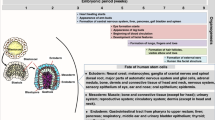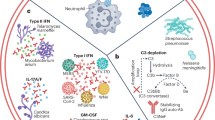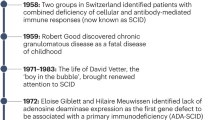Abstract
RESULTS obtained in the study of immunologieal tolerance have lent credence to the generalization that the mammalian fœtus is incapable throughout gestation of responding specifically to an antigenic stimulus. Data are accumulating, however, which suggest that in at least some mammalian species the fœtus may be able to mount an immunological response. Schinckel and Ferguson1 demonstrated that the fœtal lamb is capable of rejecting adult skin homografts in a manner comparable to that of the adult sheep. Fennestad and Borg-Petersen2 reported that fœtal calves infected in utero with Leptospira could be shown at birth to have a higher anti-Leptospira titre than their mothers. Uhr3 has observed that fœtal guinea pigs are capable of an active production of delayed hypersensitivity against protein antigens. We have observed4, following injection of antigenic stimuli into the fœtal lamb, the production of γ-globulin and of antibody by the normally agamma-globulinæmic fœtus. Finally, the older literature5 contains a number of references to the occurrence in congenital syphilis of Wassermann titres higher in the new-born's serum than in that of the mother, and to positive Wassermann titres in the child's serum in the presence of negative maternal serology. We may anticipate that future investigations will establish the earliest time of appearance of immunological differentiation in some of these species.
This is a preview of subscription content, access via your institution
Access options
Subscribe to this journal
Receive 51 print issues and online access
$199.00 per year
only $3.90 per issue
Buy this article
- Purchase on Springer Link
- Instant access to full article PDF
Prices may be subject to local taxes which are calculated during checkout
Similar content being viewed by others
References
Schinckel, P. G., and Ferguson, K. A., Austral J. Biol. Sci., 6, 533 (1953).
Fennestad, K. L., and Borg-Petersen, C., Nature, 180, 1210 (1957).
Uhr, J. W., Nature, 187, 957 (1960).
Silverstein, A. M., Kraner, K. L., Lukes, R. L., and Brown, G. A. (in preparation).
Lesser, F., Handbuch der Haut- u. Geschlechtskrankheiten, 19, 287 (J. Springer, Berlin, 1927).
Edsall, G., Ann. N.Y. Acad. Sci., 66, 32 (1956).
Black, M. M., and Speer, F. D., Blood, 14, 848 (1959).
Bridges, R. A., Condie, B. M., Zak, S. J., and Good, R. A., J. Lab. Clin. Med., 53, 331 (1959).
Silverstein, A. M., and Lukes, R. L. (in preparation).
Stowens, D., Pediatric Pathology, 187 (Williams and Wilkins Co., Baltimore, 1959).
Rietschel, H., Handbuch der Haut- u. Geschlechtkrankheiten, 19, 1 (J. Springer, Berlin, 1927).
Author information
Authors and Affiliations
Rights and permissions
About this article
Cite this article
SILVERSTEIN, A. Congenital Syphilis and the Timing of Immunogenesis in the Human Fœtus. Nature 194, 196–197 (1962). https://doi.org/10.1038/194196a0
Issue Date:
DOI: https://doi.org/10.1038/194196a0
This article is cited by
Comments
By submitting a comment you agree to abide by our Terms and Community Guidelines. If you find something abusive or that does not comply with our terms or guidelines please flag it as inappropriate.



